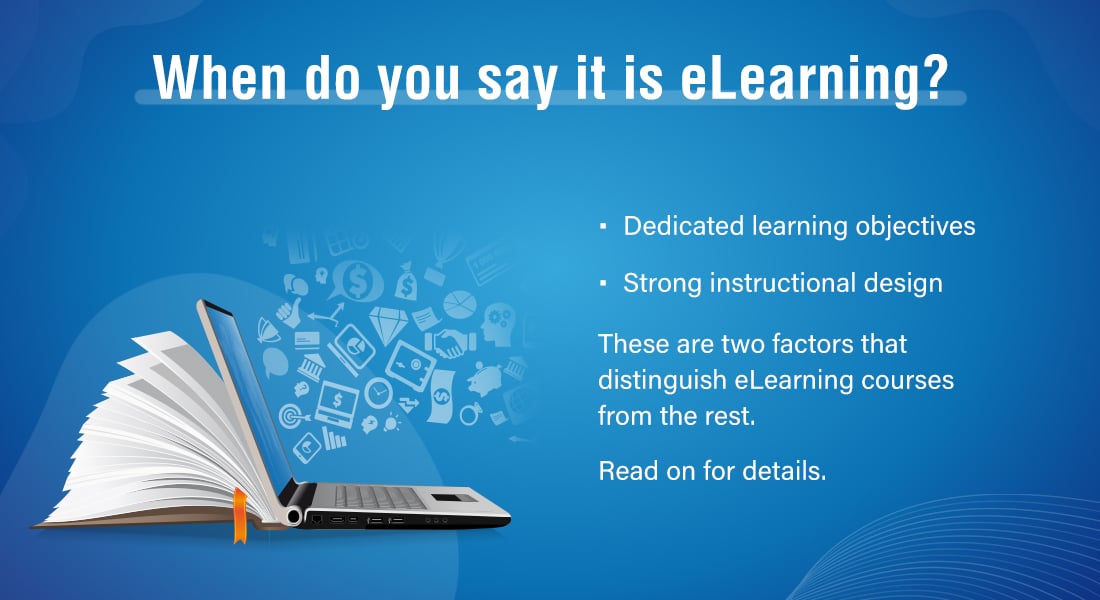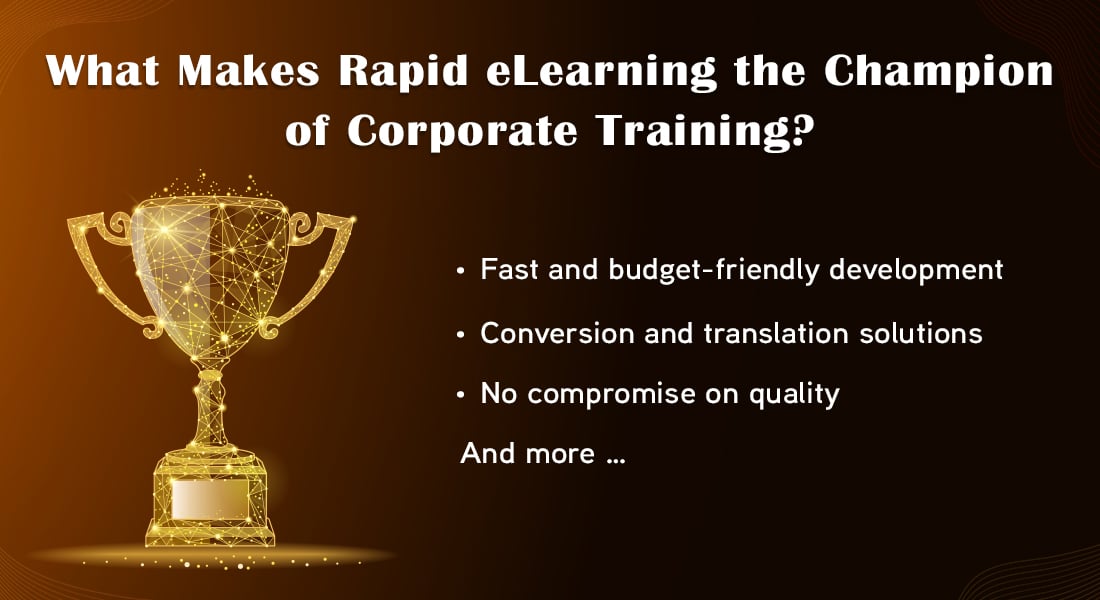What E-learning is and What It is NOT!

Just like e-mails, e-cycles, e-books, and e-currency, eLearning also implies something ‘electronic’. Put simply, eLearning is learning that is facilitated by technology. But that does not mean that all forms of learning that happen via an electronic medium can be considered eLearning. To make it more clear, your old classroom PPTs, with added audio narration and uploaded to a learning management system (LMS), IS NOT E-LEARNING!
ELearning? Or Not?
eLearning:
- Has clear performance-based learning objectives
- Is based on robust instructional design principles
- Provides opportunities for reinforcement through formative assessments
- Assesses learning through summative assessments
eLearning is not:
- Refurbished PPTs uploaded on LMS
- Recordings of classroom sessions
- Handouts and other digital resources
That said, eLearning for corporate training offers a host of benefits that repurposing old classroom PPTs does not. E-learning provides self-paced learning which learners can finish in their own time and pace. Plus, eLearning is also more cost effective, and provides more effective learning, something everyone struck by COVID-19 is desperately looking for.
This blog answers the very tricky question – what is eLearning and what is not eLearning? But to understand what eLearning is, it is important to be clear about what eLearning is not. Continue reading to understand what goes into eLearning and why corporate training managers are always advocating it.
→ Planning to convert classroom courses to eLearning? Here’s how you can do it.
What is Not E-learning?
You cannot deliver any form of training in an electronic format and call it eLearning. Given that learning is at its core, each eLearning module is specifically designed around that objective, and the eLearning design and development is based on robust instructional design principles.
The following are examples of what cannot be considered eLearning.
- PowerPoint presentations repurposed with audio narration, published with the help of an authoring tool, and uploaded to an LMS.
- Classroom recordings made digitally accessible to learners, with the option to control the playback.
- Classroom notes and handouts published as HTML5 webpages with scrolling and navigation functions enabled.
- Virtual Instructor Led Training (VILT) sessions over video conferencing tools.
While these may not be bad training strategies, they are not eLearning.
So, What is eLearning?
That’s the million-dollar question!
E-learning can be defined as learning that is facilitated by technology for its design and development, delivery, utility and assessment. To properly understand what eLearning is, we need to look at its objectives, process of development, and evaluation.
1. Objectives
Each eLearning course is specifically designed to address a set of learning objectives that the learner needs to achieve by the time they complete the course. These learning objectives need to be SMART – specific, measurable, achievable, relevant, and time-bound.
To be called an eLearning course, a course needs to:
- Teach, not inform – eLearning courses need to ‘teach’ learners and not just provide information. They should offer opportunities for learners to interact with the course to make up for the absence of an instructor.
- Facilitate self-paced learning – eLearning courses should be designed according to adult learning principles. They should offer the learner flexibility to learn at their own pace. Offering unrestricted navigation is also a good practice.
- Provide opportunities for reinforcement – Like a classroom instructor asking learners questions during the session to check understanding, eLearning also uses formative assessments throughout the course (after each unit or topic). Immediate feedback is provided for these assessments that helps reinforce the learning.
- Measure learning at completion – Summative assessments at the end of the course are evaluative in nature. They are based on the set learning objectives and help measure to what extent the learner has achieved the learning objectives of the course.
2. Process of Design & Development
For an eLearning course to be effective, it should be designed using robust instructional design (ID) principles. There are several ID models in existence but for this blog, we are focusing on two important ones – ADDIE and SAM.
- ADDIE
ADDIE stands for Analysis, Design, Development, Implementation and Evaluation.
| Analysis | Understanding the audience (level of competence and learning environment) and analyzing existing content (facilitator guides, handouts, PPTs). |
| Design | Setting performance-based objectives, formulating the instructional strategy, finalizing media elements and level of interactivity, and framing assessments. |
| Development | Building the course using authoring tools (Storyline 360, Lectora, or Captivate) and publishing it under compatible eLearning standards (SCORM 2004, xAPI or cmi5). |
| Implementation | Deploying the eLearning course on an LMS to make it accessible to all users. |
| Evaluation | Evaluating the course at 5 levels with the Kirkpatrick-Phillips Model. |
- The Successive Approximation Model SAM
The SAM is an iterative model that overcomes the drawbacks of ADDIE. It has three phases – preparation, iterative design, and iterative development. The advantage of this model is that the project does not proceed to the next phase without sign-off from stakeholders, avoiding surprises at the end and rework.
| Preparation Phase | Information on the whole project and audience is gathered, with a brainstorming session to discuss initial thoughts. |
| Iterative Design Phase | The project plan is finalized. A fully functional prototype developed and sent to stakeholders for approval. |
| Iterative Development Phase | Upon approval of the prototype, the full course is developed and sent for review. After approval, the final version is hosted on the LMS. |
3. Evaluation/Assessments
The final distinguishing card for eLearning courses is the way they address assessments in the course.
You should ask these five questions before putting a seal of approval on eLearning assessments.
- Are the assessments performance-based?
- Are both formative and summative assessments included?
- Which question type is used mainly?
- What other question types are employed in the course?
- What is the frequency of formative assessments in the course?
Wrapping it Up!
So you see, eLearning is much more than PPTs and classroom recordings uploaded on an LMS. As COVID-19 has made eLearning a buzzword in corporate training, it’s really important that we understand what eLearning is and what it is not.
Convinced enough? Want to make a business case for eLearning in your organization? Download and read this handy eBook and be an eLearning champion.





